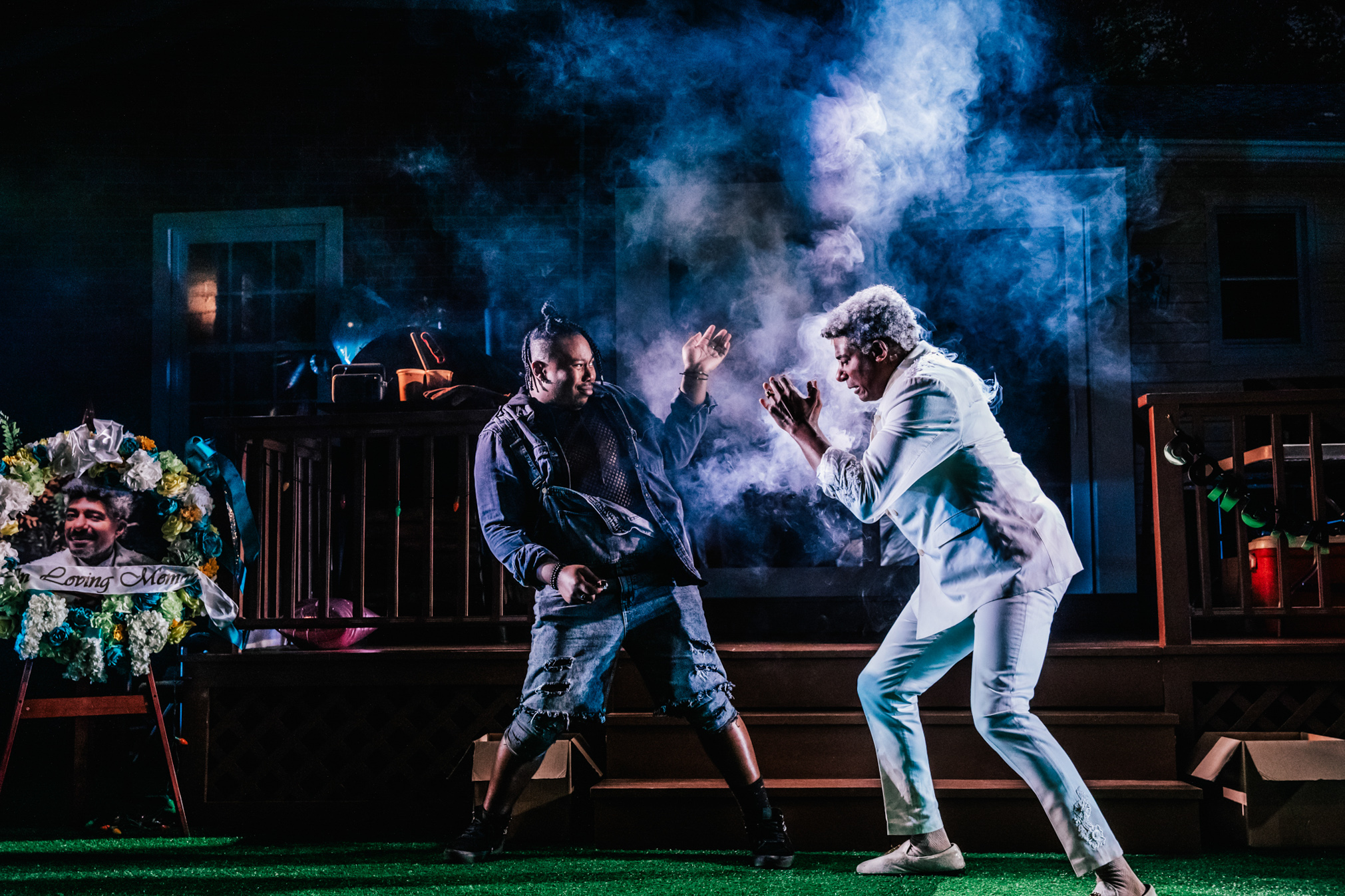Theater review: ‘Dragon Lady’ lights up stage with expressive multi-generational tale
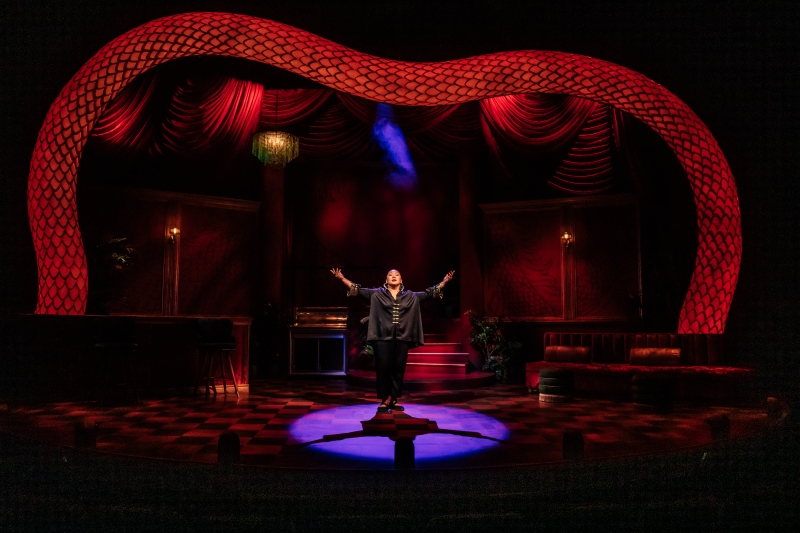
Sara Porkalob stands below a scaled red arch on the stage of “Dragon Lady.” The one-woman show is running at the Geffen Playhouse’s Gil Cates Theater through Oct. 6. (Courtesy of Jeff Lorch)
“Dragon Lady”
September 4-October 6
Gil Cates Theater
$45-$139

By Reid Sperisen
Sept. 26, 2024 12:48 p.m.
This post was updated Oct. 1 at 8:39 p.m.
With “Dragon Lady,” Sara Porkalob has created a fiery theatrical supernova.
The one-woman show is the first of three plays in “The Dragon Cycle,” a series that also includes “Dragon Mama” and the upcoming “Dragon Baby,” all written and performed by the Filipina American playwright. Directed by Andrew Russell, “Dragon Lady” premiered at Seattle’s Intiman Theatre in 2017 and will run at the Geffen Playhouse’s Gil Cates Theater until Oct. 6. The multigenerational narrative details the life of family matriarch Maria Porkalob Sr. – Sara Porkalob’s grandmother – from 1953 to 2005. Collectively, Porkalob’s infectious stage presence, deep introspection and masterful characterization deliver a spellbinding and unforgettable nearly two-hour experience.
[Related: Theater review: ‘The Brothers Size’ redefines brotherhood, remains relevant, transformative]
Porkalob captivated the auditorium’s attention from the opening scene where she appeared atop the set’s central curving staircase. Wearing an oversized black top with gold sleeve details and her hair in a tight bun, Porkalob’s appearance might at first seem simple and subdued. Admittedly, the show features no costume changes or flashy set pieces to try to add more verve to its proceedings. But it would be an egregious miscalculation to interpret Porkalob’s singular costume as a weakness of the production, as with only one outfit she manages to bring to life dozens of characters who are distinguished by spot-on voices, expressive hand gestures and an immediately believable perspective.
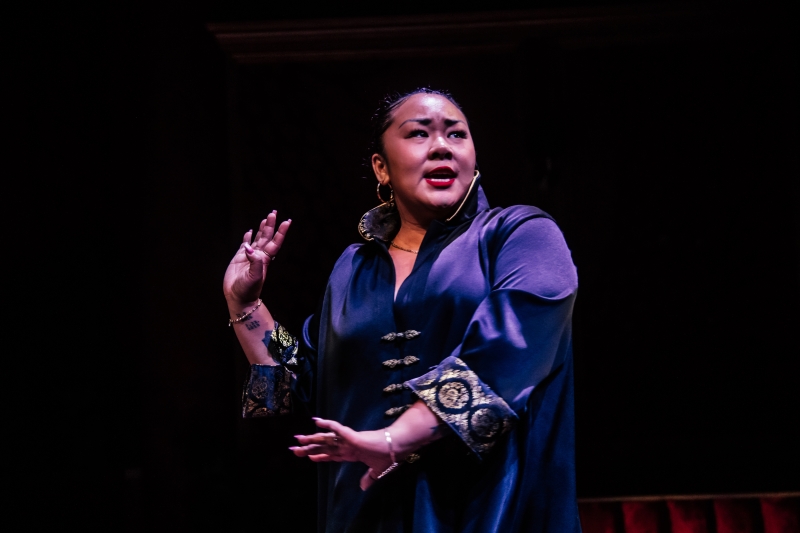
The play begins with a humorous parody of the folk classic “The House of the Rising Sun” as Porkalob Sr. celebrates her 60th birthday and speaks to her granddaughter Sara about her life story. Quickly, Maria Porkalob Jr. – Sara Porkalob’s mother – and her four siblings are introduced, though they are just the first of an assortment of personas Sara Porkalob alternates between while on stage. For Porkalob Sr., her tale evolves from being orphaned as a child on the streets of Manila, Philippines, to becoming a lounge singer at one of the city’s most luxurious clubs. As her means of survival dips into sex work, Porkalob Sr. manages to escape to America, where she tries to raise her five children as a single mother in Bremerton, Washington.
One of the show’s strongest moments arrives during the first act with the swanky original composition “A City Where It Never Rains,” which details how Porkalob Sr. fell for the powerful Manila gang boss who fathered her first child. This number is the only time in the show when Sara Porkalob is joined by another vocalist, as she croons alongside band leader and guitarist Pete Irving while he sings behind a red screen. Even as the lyrics foreshadow that Porkalob Sr.’s mysterious suitor may be untrustworthy, audiences can be easily swept up by the rousing instrumentation and romantic sentiments as Sara Porkalob’s soaring vocals are given the passionate sonic atmosphere needed to make them truly shine.
Two of the show’s other original musical numbers are played twice throughout the performance, each with visceral emotional impact. The electrifying “The Dragon Theme” and its reprise, both in the first act, elevate the cabaret stylings of the show thanks to Sara Porkalob’s energetic and dramatic renditions. Conversely, the somber and melancholy “Trouble Is A Family Trait” is played once in each act. In the first half of the show, the song depicts a sequence where Porkalob Sr.’s father is tortured and killed by Filipino gangsters. By comparison, when used as the show’s penultimate number, it morphs into a haunting lullaby as three generations of Porkalob women ruminate in the hospital immediately following Sara’s birth.
Another highlight is Porkalob’s spirited portrayals of several of the story’s supporting characters. Lola, the morally ambiguous woman in charge of the Manila lounge, is so fully realized that she would undoubtedly be deserving of a future “Dragon Lady” spinoff of her own. Porkalob’s presentation makes Lola the most sultry and provocative female character in the entire story, with a snappy cynicism as she continuously smokes a fictional cigarette. At other times in the show, Porkalob hilariously includes a sassy pet cat named Verna and offers her best takes on characters such as a gawky prepubescent boy named Kelly and Porkalob Sr.’s two-faced mother-in-law.
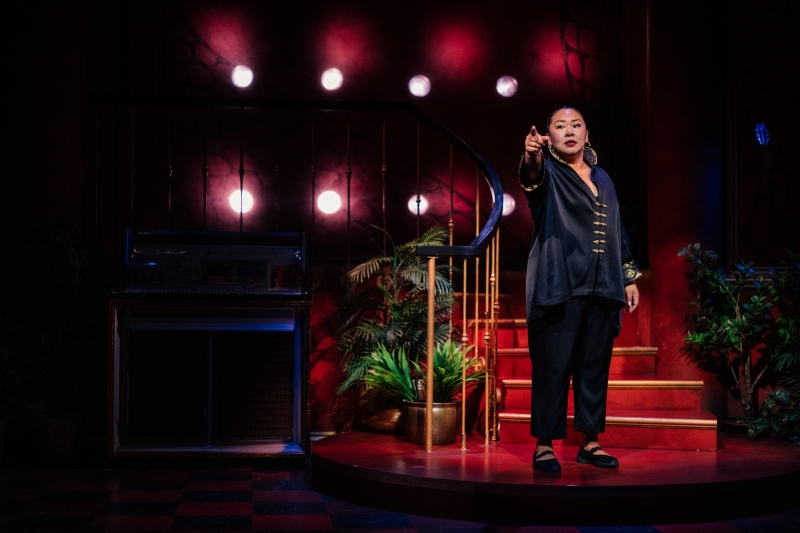
Even in parts of the narrative where several characters banter in quick succession, Porkalob effectively creates a dynamic that is replicative of having numerous actors on stage. For instance, one extended sequence in the second act presents Porkalob Sr.’s two young sons borrowing Boy Scout ensembles and attempting to collect food donations for the impoverished family. Despite stepping away from the central matrilineal storyline for several minutes to detail the boys’ tumultuous quest, Porkalob crafts a high-energy conversation between them that holds equal personality to what could have been achieved with multiple actors.
Although the set features limited moving parts or fanciful props, the simplicity of the intricately crafted stage works to its advantage. The weaving, scaled and serpent-like archway above the stage – which became a color-changing light fixture throughout the performance – was especially vibrant. Likewise, the strategic use of the theater’s spotlight at several vulnerable moments throughout the performance put further emphasis on Porkalob’s palpable emotions. Crucially, Porkalob uses every inch of the stage to command the audience’s attention and interact with the crowd, at times standing atop a bar, sitting on a velvet couch or selecting a viewer from the front row to dance and twirl together in the aisle.
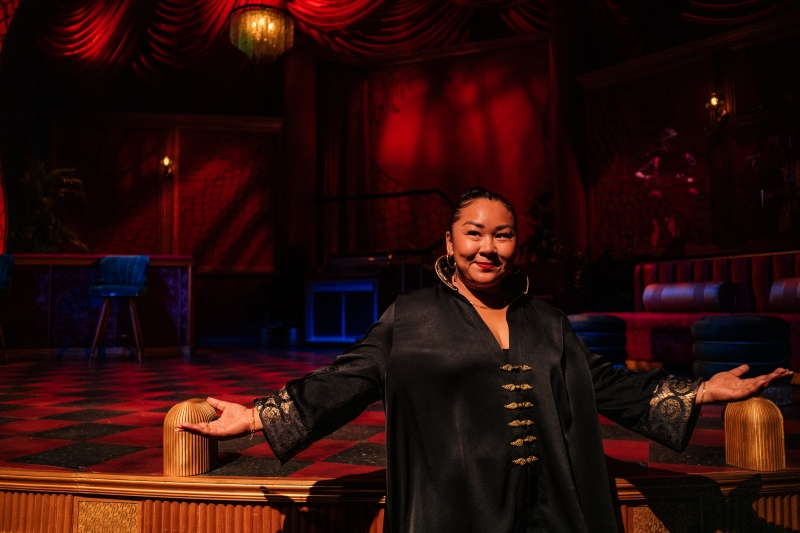
Altogether, the delightful undulating rhythm of “Dragon Lady” strikes a wildly entertaining balance that successfully jumps repeatedly between comedy, drama and tragedy, sometimes in the span of mere seconds. Porkalob consistently deploys excellent physical comedy, with her facial expressions in particular providing immense vitality to her characters. However, she is just as easily able to deliver heartbreaking and thoughtful lines with conviction and solemnity. Put simply, Porkalob’s innate ability for convincingly introducing characters – while sustaining the audience’s interest in their lives – is a display of talent in its rawest form.
[Related: Theater review: Contemporary revival of classic musical ‘Company’ is something to be celebrated]
Perhaps the most impressive aspect of all is how much heart and soulfulness Porkalob manages to infuse into every minute of the performance. Even while the play’s fast-paced script deftly touches upon several weighty topics – including race, sexuality, sexual violence, feminism, socioeconomic inequality, poverty and generational trauma – the production is imbued with an overwhelming humanity that retains considerable relatability and digestibility. The thought-provoking material of “Dragon Lady” greets its viewers with such honesty and frankness that it is able to both challenge perceptions and evoke genuine catharsis. By the end, the deserved standing ovation served as further evidence of how enraptured the audience was.
If the transcendent storytelling and magnetic acting of “Dragon Lady” is any indication, Sara Porkalob seems destined to set contemporary theater ablaze for many years to come.



